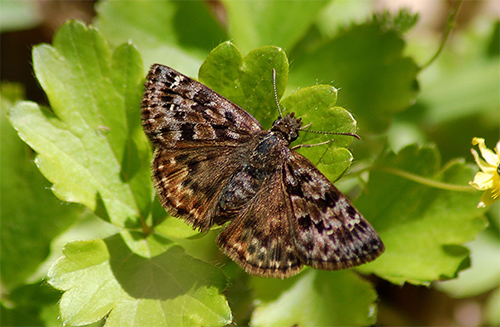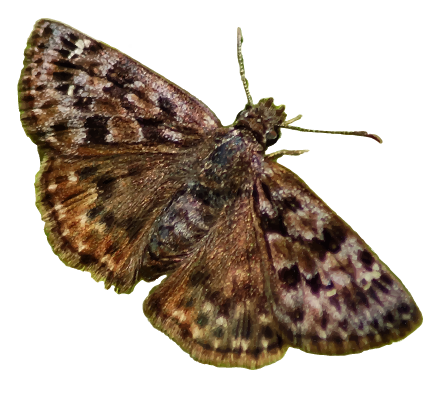Mottled Duskywing

Species information
The following is a report on progress made towards the protection and recovery of Mottled Duskywing (Erynnis martialis) in Ontario from 2007 to 2020, based on Ontario’s species-specific recovery policy. This report meets the legislative requirement for a review of progress under the Endangered Species Act, 2007 (ESA or “the Act”). Mottled Duskywing is listed as endangered on the Species at Risk in Ontario (SARO) List under the ESA.
Mottled Duskywing was listed as an endangered species under the ESA on June 27, 2014.
Mottled Duskywing has been protected from being killed, harmed, harassed, captured or taken since 2014.
In addition, the habitat of Mottled Duskywing has been protected from being damaged or destroyed since 2014.
The species-specific recovery policy for Mottled Duskywing, known as the Government Response Statement (GRS) was published in 2016 and includes the government’s recovery goal for the species and the actions and priorities it intends to lead or support to help achieve that goal. The GRS considers science advice provided in the recovery strategy when developing recovery actions for the species. As legislated in the Act, the purpose of this review is to report on progress made towards implementing the protection and recovery actions in the GRS. The review can also help identify opportunities to adjust and adapt the implementation of protection and recovery actions to achieve the recovery goal for the species.
Further information about Mottled Duskywing, including the threats that it faces, and actions being taken to help protect and recover this species is available on the Government of Ontario webpage for Mottled Duskywing. A summary on the progress towards the protection and recovery of Mottled Duskywing and an annual update on the broader species at risk program (i.e. the Introduction to the 2021 Review of Progress report) is available on the Review of Progress towards the Protection and Recovery of Ontario’s Species at Risk webpage.
Snapshot: Progress towards the protection and recovery of Mottled Duskywing
Progress towards meeting the recovery goal
- The recovery goal in the Government Response Statement (GRS) for Mottled Duskywing in Ontario is to “allow for the long-term persistence of the species across its range in Ontario by reducing existing threats to metapopulations and the species' habitat. The government supports investigating the feasibility of augmenting existing populations and of reintroducing the species to historic sites with suitable habitat.”
- Progress has been made towards implementing all of the government-led actions. Progress has been made towards implementing all of the government-supported recovery objectives and all of the associated actions. Examples of progress include:
- management of Mottled Duskywing habitat through methods such as prescribed burning, deer population control, and tree canopy thinning
- population monitoring and presence/absence surveys at extant and historical metapopulation sites
- research to address knowledge gaps in areas such as Mottled Duskywing dispersal ability and larval density dependence on host plants
- collaboration with conservation organizations to plan efforts to reintroduce Mottled Duskywing to Pinery Provincial Park
- In alignment with the GRS, continued effort is required to estimate population size and map host plant extent of occurrence for all metapopulations. Further research is needed to investigate the habitat requirements of Mottled Duskywing and investigate cues used by Mottled Duskywing larvae to break diapause (a state of inactivity in response to environmental stressors such as winter weather).
Occurrences and distribution
- Twenty-nine populations of Mottled Duskywing have been documented in Ontario. Currently, 13 of these populations are extant and 14 are considered historical. Two populations are considered extirpated.
- The Natural Heritage Information Centre (NHIC) has received over 2,550 records of the species based on observations made between 2008 and 2020.
- Since 2008, the species has been observed in four locations where it was not previously known to occur, while one population changed from historical to extant as its existence was confirmed through monitoring efforts.
Government-supported stewardship projects
- Through the Species at Risk Stewardship Program, the Government of Ontario has enabled its stewardship partners to conduct 17 projects (by providing $878,997 in funding) that have supported the protection and recovery of Mottled Duskywing. Three projects ($81,451) focused exclusively on Mottled Duskywing, while the other 14 projects ($797,546) focused on multiple species at risk, including Mottled Duskywing.
- The government’s support helped its stewardship partners to involve 890 individuals who volunteered 12,850 hours of their time towards protection and recovery activities for species at risk, including Mottled Duskywing. The estimated value of these voluntary contributions, as well as additional funding and in-kind support, is $1,286,382.
- Stewardship partners reported that through their actions 2,380 hectares of habitat were enhanced for Mottled Duskywing and other species at risk that inhabit the same ecosystem.
- Stewardship partners reported providing outreach on multiple species at risk, including Mottled Duskywing, to 13,901 individuals.
Supporting human activities while ensuring appropriate support for species recovery
- The Government of Ontario has issued two permits for this species, both of which were ‘protection or recovery’ permits issued under clause 17(2)(b) of the ESA for this species.
- Six activities have been registered for the species. The activities were registered under ‘Ecosystem protection’ (section 23.11), ‘Pits and quarries’ (section 23.14) and ‘Species protection or recovery activities’ (section 23.17) under Ontario Regulation 242/08 of the ESA.
Reporting on the progress towards the protection and recovery of Mottled Duskywing
Recovery goal
The government’s goal for the recovery of Mottled Duskywing is to allow for the long-term persistence of the species across its range in Ontario by reducing existing threats to metapopulations and the species' habitat. The government supports investigating the feasibility of augmenting existing populations and of reintroducing the species to historic sites with suitable habitat.
The implementation of government-led and government-supported actions demonstrates progress towards reaching the desired objectives and the recovery goal set out in the GRS.
Progress towards implementing government-led actions
Progress has been made towards implementing all government-led actions identified in the GRS. Common actions for the government to lead as it works towards achieving a species’ recovery goal include:
- Educate other agencies and authorities involved in planning and environmental assessment processes on the protection requirements under the ESA.
- Encourage the submission of Mottled Duskywing data to the Government of Ontario’s central repository at the Natural Heritage Information Centre (NHIC).
- Undertake communications and outreach to increase public awareness of species at risk in Ontario.
- Support conservation, agency, municipal and industry partners, and Indigenous communities and organizations to undertake activities to protect and recover the Mottled Duskywing. Support will be provided where appropriate through funding, agreements, permits (including conditions) and/or advisory services.
- Encourage collaboration, and establish and communicate annual priority actions for government support in order to reduce duplication of efforts.
Additionally, the government has directly undertaken the following species-specific actions:
- Continue to manage the habitat of Mottled Duskywing in provincially protected areas to maintain the ecological integrity of its habitat and to minimize the threat of recreational pressures and impacts.
- Continue to implement the Ontario Invasive Species Strategic Plan to address the invasive species (e.g. Dog Strangling Vine) that threaten Mottled Duskywing.
- Protect the Mottled Duskywing and its habitat through the ESA. Develop and enforce the regulation identifying the specific habitat of the species.
Key progress made towards implementing these actions is described in the following sections.
The government continues to manage species at risk habitat at Pinery Provincial Park to maintain ecological integrity and minimize the threat of recreational pressures. Action undertaken by Ontario Parks includes management of Mottled Duskywing habitat through prescribed burning and invasive species control. Deer population management in recent decades has helped to re-establish the host species (Ceanothus plants) in the park, making reintroduction feasible. Ontario Parks is currently working with the Ontario Butterfly Species at Risk Recovery Team to reintroduce Mottled Duskywing to Pinery Provincial Park. In the summer of 2021, approximately 400 larvae, 145 adults and 90 pupae were released.
Ontario’s Invasive Species Act
The GRS for Mottled Duskywing indicates that invasive species (e.g. Dog Strangling Vine) pose a threat to the survival and recovery of the species in Ontario. The Ontario Invasive Species Strategic Plan, 2012 and the Invasive Species Act, 2015 provide the policy and legislative framework to prevent new invaders from arriving and surviving in Ontario; to slow and where possible reverse the spread of existing invasive species, and to reduce the harmful impacts of existing invasive species, including impacts on species at risk. This framework may support the implementation of actions to reduce the threats from invasive species.
Occurrences and distribution
Twenty-nine populations of Mottled Duskywing have been documented in Ontario. Thirteen are considered to be extant (i.e., observed within the past 20 years), fourteen are considered to be historical
Since 2008, the government’s central repository at the NHIC has received 2,559 records of the species. These records are based on observations from 2008 to 2020 and come primarily from research and monitoring programs completed by conservation authorities, educational institutions and the private sector. Based on these records, four populations that were previously unknown have been identified, including significant populations at Marmora and Alderville Black Oak Savanna (estimates of 195 and 681 individuals, respectively). A population from the Northumberland Forest - North Burns Area that had not been observed since 1986 was re-observed between 2015 and 2018, and that population is now considered extant.
The newly-identified local populations are the result of increased search effort through targeted surveying and research projects for Mottled Duskywing and do not likely represent actual population increases, but rather increased knowledge about the distribution of the species. Data collected and submitted to the NHIC has been used to rank the viability of populations at four extant sites: Aldershot (‘Good’), Marmora (‘Good to Fair’), Alderville Black Oak Savanna (‘Good to Fair’) and Bronte Creek Provincial Park (‘Fair’).
It is possible that there are observations of Mottled Duskywing that have not been submitted to the government. Encouraging the submission of observations of this species is included in the GRS as a government-led action. Submission of species observations increases our knowledge of where they occur and can play an important role in assessing the viability of species populations.
Everyone is encouraged, or may be required by an authorization or approval to submit observations of Mottled Duskywing, and any other species at risk observed, to the NHIC for incorporation into the provincial record of observations. Observations may now be submitted to NHIC via the Rare Species of Ontario project in iNaturalist.
-
2,559observations of this species were submitted to the NHIC since 2008
Government-supported stewardship projects
An important government-led action in the GRS for Mottled Duskywing is to support partners to undertake activities to protect and recover the species. Through the Species at Risk Stewardship Program the government has supported 17 projects ($878,997) designed to contribute to the protection and recovery of Mottled Duskywing
Stewardship partners reported that provincial funding helped them to secure in-kind support by involving 281 individuals who volunteered 1,560 hours of their time towards protection and recovery activities that focused exclusively on Mottled Duskywing, which has an estimated value of $32,234. As well, 609 individuals volunteered 11,290 hours of their time towards protection and recovery activities for multiple species at risk, including Mottled Duskywing, which has an estimated value of $397,161. Partners also reported that through both their efforts and the efforts of their volunteers to implement GRS actions, they were successful in enhancing 2,380 hectares of habitat that will benefit multiple species at risk, including Mottled Duskywing. In addition, stewardship partners reported providing focused outreach on Mottled Duskywing to 1,294 individuals, as well as ecosystem-based outreach on multiple species, including Mottled Duskywing, to 12,607 individuals.
The remainder of this section highlights two projects supported through the Species at Risk Stewardship Program as well as the corresponding government-supported recovery actions for the species.
Since 2015, the Ontario Butterfly Species at Risk Recovery Team has worked to support the recovery of Mottled Duskywing, with the goal of reintroducing the species to parts of its historical range. A recent project supported by the Species at Risk Stewardship Program and involving numerous collaborating organizations has helped to address several knowledge gaps identified in the Mottled Duskywing GRS. Field crews conducted mark-resighting surveys at two metapopulation locations, contributing to ongoing efforts to monitor Mottled Duskywing and estimate population size and survival. Researchers also captured mated females and transported them to a lab where they measured the number of eggs produced per individual and assessed egg viability. This life history information helps implement the GRS action to determine recruitment rates for population viability analysis. A sample of newly hatched larvae were then deposited on New Jersey Tea cuttings at varying densities to investigate density dependence on larval host plants, contributing to the high priority action of investigating habitat requirements for Mottled Duskywing. The work in this study also contributed to the GRS action to investigate the feasibility of augmenting existing populations by demonstrating successful capture, captive rearing and release of Mottled Duskywing. In the summer of 2021, as part of a follow-up project, Mottled Duskywing was reintroduced to Pinery Provincial Park.
ALUS Canada works with farmers and local community partners to create, enhance, restore and manage habitat to support species at risk recovery in Ontario. Since 2016, ALUS Canada has worked with local communities to enhance over 300 hectares of habitat in regions that are home to current or historical Mottled Duskywing metapopulations, including planting the larval host plant New Jersey Tea. ALUS Canada’s projects also contribute to the development and implementation of education, awareness and stewardship programs about Mottled Duskywing and its habitat through regular presentations, workshops, and public communications.
Species at Risk Stewardship Program
-
 17
17projects included Mottled Duskywing
-
 3
3project for Mottled Duskywing exclusively
-
 $797,546
$797,546for multi-species projects that included Mottled Duskywing
-
 $81,451
$81,451for Mottled Duskywing exclusively
-
 $1,286,382
$1,286,382in additional funding and in-kind support
-
 890
890volunteers
-
 12,850
12,850volunteer hours
-
 13,901
13,901people received outreach
-
 2,380
2,380hectares of habitat enhanced
Supporting human activities while ensuring appropriate support for species recovery
Supporting partners through authorizations and their associated conditions is an important government-led action.
Two permits have been issued for Mottled Duskywing since the species has been protected under the ESA, both of which were ‘protection or recovery’ (17(2)(b)) permits. ‘Protection or recovery’ permits are issued if the purpose of the activity is to assist in the protection or recovery of a species at risk. Of the two permits, both were issued exclusively for Mottled Duskywing. These permits allowed organizations to undertake recovery activities such as monitoring, research, and captive rearing.
No agreements were entered into for Mottled Duskywing through Ontario Regulation 242/08 (prior to the July 1, 2013 amendment).
Six activities that may affect Mottled Duskywing or its habitat have been registered for the purposes of Ontario Regulation 242/08 under the ESA. One activity was registered under ‘Ecosystem protection’ (section 23.11), one activity under ‘Pits and quarries’ (section 23.14) and four activities under ‘Species protection or recovery’ (section 23.17). These registrations require the registrant to comply with all conditions of the regulation, such as:
- preparing a mitigation plan using the best available information on steps that may help minimize or avoid adverse effects on the species
- monitoring the effectiveness of the steps taken to minimize adverse effects on the species
- reporting observations of the species using the Ontario Species at Risk Observation Reporting Form and submitting them to the NHIC
-
2protection or recovery permits
-
6registrations
Progress towards implementing government-supported actions
Government-supported actions are organized under overarching recovery objectives. Progress has been made towards achieving all government-supported recovery objectives and implementing all of the associated actions identified in the GRS for Mottled Duskywing.
Objective: Work with local landowners and community partners to manage habitat through threat mitigation and increased public awareness.
- Action No. 1 (High Priority) – Using the best available information, work collaboratively with stakeholders including landowners, conservation authorities, and First Nations, to manage habitat by:
- implementing appropriate methods to prevent woody succession and to thin the canopy and sub-canopy cover, as needed
- implementing measures to reduce the threat of deer browsing
- reducing the usage of pesticides that may harm Mottled Duskywing or its host plants
- targeting the removal of invasive species threatening Mottled Duskywing habitat
- evaluating the effectiveness of habitat management activities including prescribed fire, wildfire suppression, and deer management
- Action No. 2 – Develop and implement education, awareness, and stewardship programs about Mottled Duskywing and its habitat, incorporating components of the pesticide application awareness program to reduce usage in habitat areas.
Under this objective, progress has been made towards implementing both actions.
Progress towards Action No. 1 has been achieved through projects supported by the Species at Risk Stewardship Program. Multiple collaborating organizations have undertaken work to improve habitat at extant and historical metapopulation locations, including work to reduce canopy cover and remove invasive species.
Action No. 2 has been achieved through multiple projects supported by the Species at Risk Stewardship Program projects focused on promoting awareness and delivering education about Mottled Duskywing and its threats and habitat. These projects have used a variety of outreach methods such as print materials and participatory workshops to engage members of the public.
Objective: Increase knowledge of the species' abundance, distribution, and site-specific threats.
- Action No. 3 (High Priority) – Collaborate with local partners, community members and First Nations to develop and implement a monitoring program for Mottled Duskywing that includes:
- developing a standardized survey protocol to confirm presence/absence and estimate population numbers
- estimating the population abundance of each existing metapopulation
- conducting surveys of historical locations to determine presence/absence
- assessing and identifying site-specific threats to populations
- mapping the extent of the host plants at each existing metapopulation location
Under this objective, progress has been made towards implementing Action No. 3 through projects supported by the Species at Risk Stewardship Program. Collaborating organizations have developed a standardized survey protocol and conducted surveys for Mottled Duskywing at each existing metapopulation location. Population estimates have been developed for the Alderville and Marmora metapopulations, and initial efforts have been made to map host plants or host plant habitat at three metapopulation sites.
Objective: Increase knowledge of the Mottled Duskywing habitat requirements, life processes and population dynamics.
- Action No. 4 (High Priority) – Investigate the habitat requirements of Mottled Duskywing and the responses to habitat management techniques by:
- determining the minimum patch size and density of larval host plants required to support a viable population of Mottled Duskywing
- conducting research on preferred nectar sources
- conducting research on the impacts of climate change on larval food plants
- mapping the present day extent of larval host plant species
- Action No. 5 – Investigate cues/triggers used by Mottled Duskywing larvae to break diapause to better understand the potential implications of climate change on the species.
- Action No. 6 – Investigate the ability of Mottled Duskywing to disperse within and between habitat patches and identify any specific requirements to facilitate movement and gene flow.
- Action No. 7 – Determine the annual population growth and recruitment rates to contribute to a population viability analysis of existing metapopulations.
- Action No. 8 – Investigate the feasibility of augmenting those existing populations that currently have very small populations and the feasibility of reintroducing the species to historic sites with suitable habitat.
Under this objective, considerable progress has been made towards implementing Action No. 8, progress has been made towards implementing Action No. 6 and Action No. 7, and initial progress has been made towards implementing Action No. 4 and Action No. 5.
Initial progress towards Action No. 4 and Action No. 5 has been achieved through projects supported by the Species at Risk Stewardship Program. In lab settings, researchers investigated larval density dependence on host plants, and examined possible light cues impacting pupation and diapause (a state of inactivity in response to environmental stressors such as winter weather). Mark-resighting surveys conducted with support of the Species at Risk Stewardship Program have allowed researchers to investigate the dispersal ability of Mottled Duskywing (Action No. 6).
Progress towards Action No. 7 has been made through various Species at Risk Stewardship Program projects that included collection of annual population data for select metapopulations, and research to estimate recruitment rates. Lab-based research has also contributed towards Action No. 8, with researchers developing captive rearing protocols to support augmentation and re-introduction efforts.
Summary of progress towards meeting the recovery goal
The recovery goal for Mottled Duskywing is “to allow for the long-term persistence of the species across its range in Ontario by reducing existing threats to metapopulations and the species' habitat. The government supports investigating the feasibility of augmenting existing populations and of reintroducing the species to historic sites with suitable habitat.” Effort made towards the government-led and government-supported actions has helped to make progress towards this goal. For example, habitat management by Ontario Parks and various organizations supported by the Species at Risk Stewardship Program has reduced threats such as woody succession and invasive species. Research and monitoring efforts undertaken through Species at Risk Stewardship Program-supported projects include population estimates and captive rearing, which are important steps in determining the feasibility of population augmentation and re-introduction of the species to existing and historical locations, respectively. In addition, the provincial record of observation indicates that since 2008, Mottled Duskywing has been discovered in four new locations where it was previously unknown, and a fifth population was reconfirmed as extant from historical. Although this increase in the known range likely reflects increased search effort rather than true expansion of the species, identifying the full range and distribution of Mottled Duskywing is an important step in promoting the long-term persistence of the species.
Recommendations
As stated in the GRS, this review of progress can be used to help identify whether adjustments to the implementation of GRS actions are needed to achieve the protection and recovery of the species. Based on progress to date, the overall direction provided in the GRS for Mottled Duskywing, particularly the implementation of actions identified as high priority, should continue to guide protection and recovery of the species.
Although initial progress has been made towards the actions to manage habitat (Action No. 1) and implement a monitoring program (Action No. 3) for Mottled Duskywing, further work is required to fully implement these actions for all metapopulations. Additional work is also required to investigate the ability of Mottled Duskywing to disperse within and between habitat patches and to identify specific requirements to facilitate movement and gene flow (Action No. 6).
Relative to actions that have received a stronger level of support, the following actions have received less attention and are identified for consideration in future work towards the protection and recovery of the species:
- Action No. 4 (High Priority) – Investigate the habitat requirements of Mottled Duskywing and the responses to habitat management techniques by:
- determining the minimum patch size and density of larval host plants required to support a viable population of Mottled Duskywing
- conducting research on preferred nectar sources
- conducting research on the impacts of climate change on larval food plants
- mapping the present day extent of larval host plant species
- Action No. 5 – Investigate cues/triggers used by Mottled Duskywing larvae to break diapause to better understand the potential implications of climate change on the species.
Protecting and recovering Mottled Duskywing will continue to be a shared responsibility that will require the involvement of many individuals, organizations and communities. Financial support for the implementation of actions may be available through the Species at Risk Stewardship Program. The government can also advise if any authorizations under the ESA or other legislation may be required to undertake a project. By working together, progress can continue to be made towards protecting and recovering Mottled Duskywing in Ontario.
Footnotes
- footnote[1] Back to paragraph A population is considered historical if it has not been recorded within the last 20 years. Historical populations may still exist, but updated information is not available.
- footnote[2] Back to paragraph Some projects supported through the Species at Risk Stewardship Program may require a 17(2)(b) permit in order to carry out the project. As a result, some 17(2)(b) permits indicated in this report may have been issued to authorize those projects.